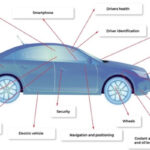In vehicle infotainment (IVI) systems are increasingly important and complex. What’s needed from a microcontroller (MCU) in an IVI? A lot, but exactly what depends on the sophistication and mix of info and ‘tainment. Multiple cores are often needed, and so are hardware accelerators for compute-intensive functions. Considerations include connectivity, human-machine interfaces (HMIs) beyond simple flat panel displays, memory management, and more. Software-defined functionality and over-the-air (OTA) updates are also important.
This FAQ begins with a brief overview of IVI functions including emerging advanced functions like driver attention monitoring and gesture recognition, looks at the growing demand on IVIs for expanded connectivity, presents a typical IVI system architecture, typical IVI MCU functionalities, and a typical IVI system on chip (SoC) and closes with a brief review of security and safety standards related to IVIs and other automotive systems.
IVIs provide the command center for vehicle operations and support for essential services. The cockpit domain controller coordinates driver information and control functions using touch screens, software-defined controls, and voice commands. In advanced designs, the domain controller can also monitor the driver’s attention and focus on driving. A variety of MCUs will be required to support audio and video interfaces for drivers and passengers and to add new comfort and entertainment applications as well as advanced driver assistance capabilities. The trend is toward personalization and flexibility through software-defined functions that are replacing centralized architectures with distributed computing capabilities, more memory, and faster connectivity (Figure 1).

Cars are becoming independently aware of passengers. Advanced systems have been proposed using millimeter wave (mmWave) radar to detect and categorize passengers versus packages and other objects in the cabin, enabling the IVI to be more proactive and interactive. IVI systems are also available that support biometric authentication, like facial recognition or fingerprint scanning, to provide a more secure and personalized experience. Biometrics can also be used to limit access to specific features and prevent theft. Driver monitoring systems are beginning to appear and are expected to be mandated by safety regulatory bodies. These systems will require an IVI that can identify the driver and monitor facial features to determine driver attention.
Gesture control is being developed for IVI systems. Technologies for gesture recognition include mmwave radar and ultrasonics. Vertical-cavity surface-emitting laser (VCSEL) technology is also being considered for gesture recognition. IVI SoCs will incorporate machine learning accelerators to support improved accuracy.
More connections
A connected vehicle has been defined as one equipped with Internet connectivity and able to send and receive data. Today, that’s only the beginning. IVI MCUs are required to manage connections to Wi-Fi (including the creation of local networks), smartphones, wireless sensors, GPS, and other devices. Various levels of connectivity are emerging that support value-added services for drivers and passengers. For a deeper dive into these developments, check out the FAQ on “What are the five levels of vehicle connectivity?”
Smartphone connectivity is growing in importance in IVI systems. It includes Wi-Fi networking and wireless charging. Bring-your-own-device (BYOD) connectivity is supported by several IVI SoCs that tightly integrate users’ smartphones with the IVI system. And the IVI connects to the car’s CAN bus, Ethernet, USB, PCIe, and other wired networks.
5G is replacing 4G as the standard for IVI systems. Its higher speeds can support higher definition maps, updated in real-time with weather and traffic information, and new services ranging from vehicle diagnostics to interactive entertainment. IVIs are beginning to incorporate graphic processing units (GPUs) to support gaming and subscription-based services.
OTA updates are becoming important for IVI systems. OTA improves system operation over time by allowing car makers to update existing features and fix bugs. 5G cloud connectivity is becoming a key element supporting OTA for IVIs and for the overall vehicle.
IVI system architecture
IVI control units support a wide range of functions like (Figure 2):
- Wired connectivity including CAN-FD, Ethernet, USB, display connectivity, and others.
- Sensors including cameras, MEMS microphones, gesture recognition subsystems, inertial measurement units (IMUs), and so on.
- Audio including a mix of class AB and class D amplifiers, surround systems, and adaptive audio.
- Positioning including MEMS IMUs and GNSS receivers.
- Wireless connectivity for broadcast signals, Bluetooth, near-field connectivity, and Wi-Fi.

IVI processor
A typical IVI MCU, like the one illustrated in the Control Unit in the center of Figure 2 above, includes a 32-bit RISC processor with enhanced security features, cryptographic accelerators, and improved flash memory capability up to 500 kcycles with 15 years of data retention. To improve performance, it uses the Thumb-2 instruction set that’s an enhancement to the 16-bit Thumb instruction set. Thumb 2 adds 32-bit instructions that can be freely intermixed with 16-bit instructions in a program and enables an MCU with Thumb-2 to cover the full functionality of the ARM instruction set.
The use of two CPUs in lockstep mode plus error detection in sensitive memories and hardware logic provides strong and multiple protection mechanisms for high detection coverage and supports the development of highly secure software.
Two series communication slave interfaces are compatible with ISO/IEC 7816-3 and a single wire protocol (SWP) that supports near-field communications with smart cards and similar devices in secure applications. Other communications interfaces include a master/slave serial peripheral interface (SPI) and I2C. The slave SPI operates up to 48 MHz, and the master is rated up to 15 MHz. The I2C interface operates at up to 1 Mbit/s.
Multiple timers are integrated including a permanent timer (PMT) with a count capability in low-power mode, three general-purpose 16-bit timers, and a watchdog timer.
Security is a primary concern and includes hardware accelerators and advanced cryptographic functions like:
- Platform and flash memory loader security certification target under a Common Criteria framework that enables designers to specify security functional requirements (SFRs) and security assurance requirements (SARs).
- The 3-key triple DES accelerator (EDES+) peripheral supports a data encryption standard (DES) hardware security-enhanced accelerator.
- A NESCRYPT (NExt Step CRYPTo-processor) light low power (LLP) cryptoprocessor efficiently supports the public key algorithm.
- The advanced encryption standard (AES) and SM4 security-enhanced accelerators ensure secure and fast AES and SM4 implementations.
- 16- and 32-bit cyclic redundancy check (CRC) calculation blocks that support standards like ISO 13239 and IEEE 802.3.
- An active shield that protects against faults caused by probing or manipulating signals and adding or removing features from the MCU.
- A true random number generator (TRNG) for producing random numbers instead of a pseudo-random number generator, which uses deterministic algorithms to produce a sequence of numbers that appear random but are not.
IVI SoC
To support IVI systems, SoCs have been developed with multiple cores like a 32-bit ARM multicore processor with an out-of-order superscalar pipeline running at up to 2.5 GHz that can support concurrent applications. Additional lower power cores are included to support real-time interrupt-intensive activities, and GPUs are included for high-performance HMIs. Some IVI SoCs also include a high-performance DSP for applications like voice recognition, surround-view stitched video, and various software-defined functions.
Entertainment is an important aspect of IVI systems, and it’s common for the display subsystem to simultaneously support multiple 1080p screens with higher resolutions and larger displays in advanced systems. IVI SoCs also include hardware accelerators that can support high-def video decoding and encoding. Audio processing is an important aspect of the info and ‘tainment functions including speech processing, voice recognition, active noise canceling and multi-zone audio (Figure 3).

Safe and secure
With increasing connectivity and OTA updates, security is critical to IVI system implementations. The SOC needs to address cybersecurity threats and vulnerabilities. Several standards have been developed to ensure the safety and security of IVIs including:
ISO 21434 is specific to cybersecurity in the automotive industry. Coverage includes the design and development of secure systems in vehicles. It addresses management of software updates and the use and management of open-source software.
ISO 21448 focuses on the safety of the intended functionality (SOTIF) in automotive systems. Coverage includes the safety of advanced driver assistance systems (ADAS) and autonomous driving systems (ADS). It also addresses the need to identify and mitigate cybersecurity threats and vulnerabilities.
ISO 26262 includes guidelines related to functional safety in vehicles and the development of safe systems, including the identification of hazards and the implementation of measures to mitigate them. Management of software updates is also covered.
Summary
IVIs are important systems in modern vehicles providing drivers with information, passengers with entertainment plus information, and are beginning to monitor driver attention and awareness. These diverse functions are demanding more and more connectivity for IVIs. Depending on the system architecture and functions included, IVIs can be implemented with high-performance MCUs or with SoCs.
References
Automotive and Infotainment Technologies, Mistral
Designing In-Vehicle Infotainment Systems in 2023, Tremend
How do MCUs support automotive infotainment systems, Infineon
Infotainment Head Unit, STMicroelectronics
Today’s high-end infotainment soon becoming mainstream, Texas Instruments





